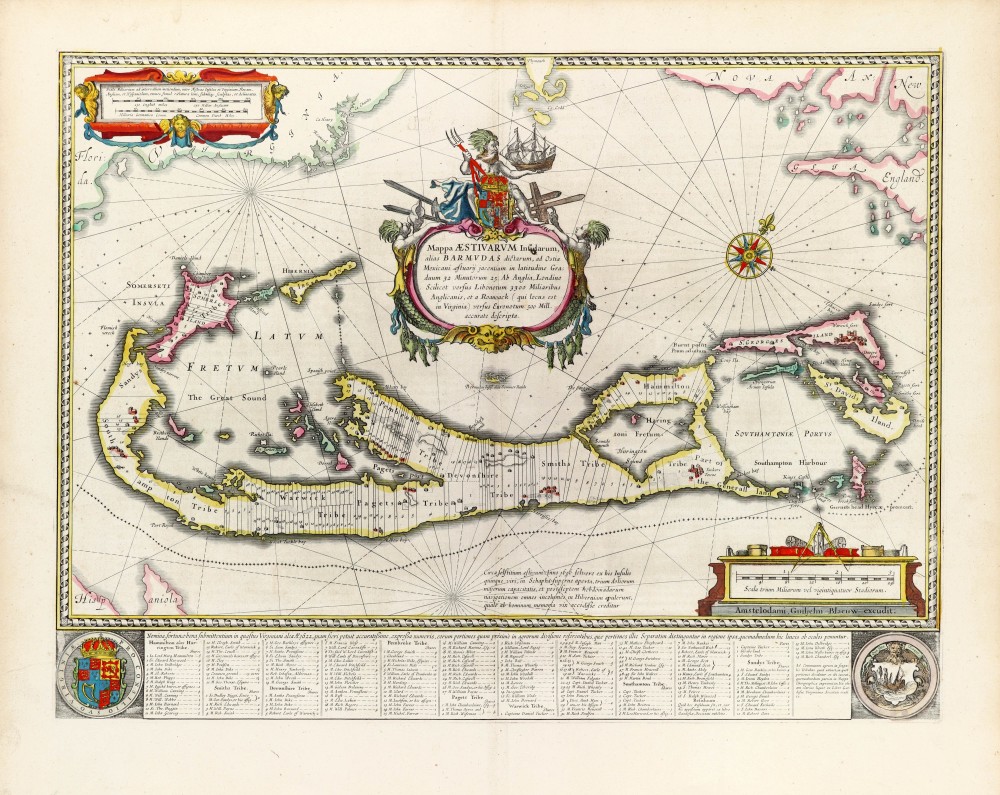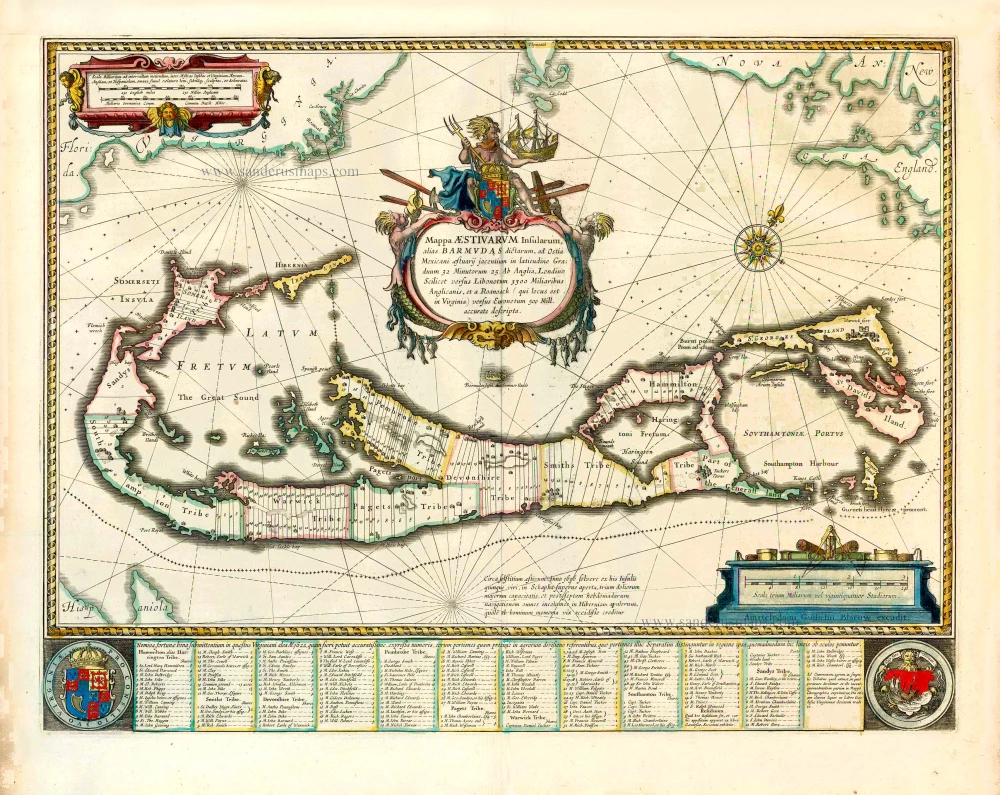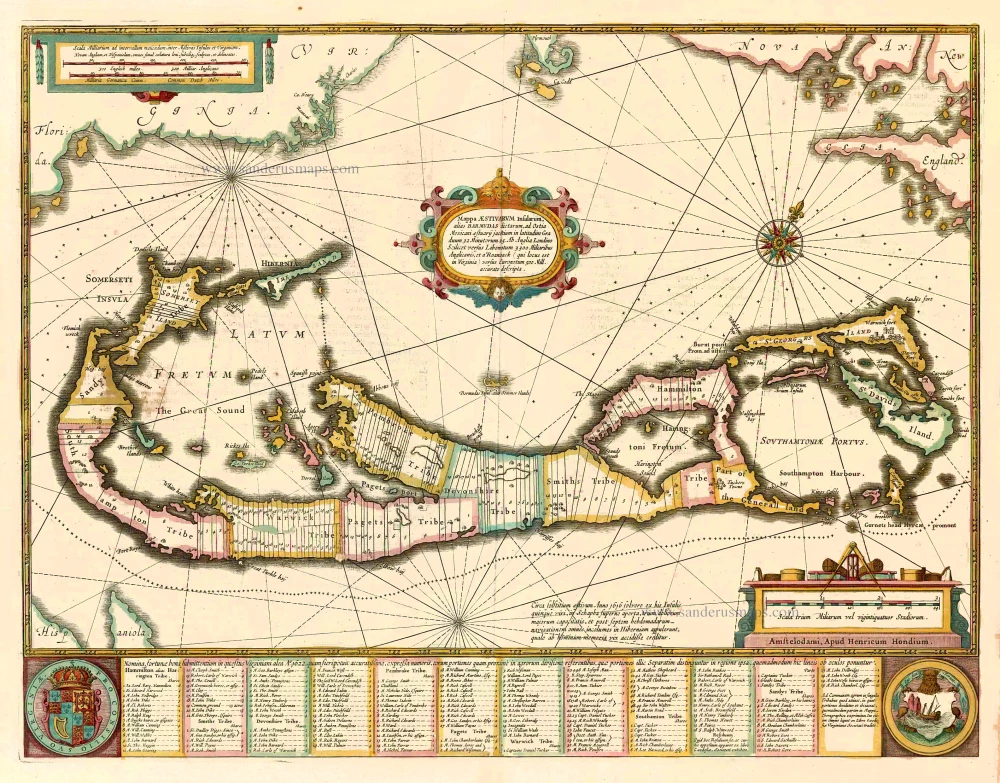Bermuda by Willem Blaeu 1640
"The most striking and technically brilliant map of Bermuda in the 17th century" (Palmer)
Bermuda is believed to have been discovered by accident in 1505 by a Spaniard, Juan de Bermudez. However, because it was so small, the group of islands remained uninhabited until an English expedition in 1609. In 1615 the Bermuda Company was founded to invest and profit from the new colony, and Richard Norwood was sent to survey the islands, using a canoe to travel around. In 1617 he divided Bermuda into large parishes and then 25-acre (10-hectare) strips of shares to be sold to settlers, as depicted on the map.
His island map was published in 1622, but no surviving example is known today. However, a derivative appeared in Speed's world atlas, the Prospect of the Most Famous Parts of the World, and this is believed to be the source for several continental copies.
One of the most amusing cartographic mistakes developed from Norwood's map. To show the position of Bermuda on the mainland, the outline of North America is shown, with New England on the right and Florida on the left, with a small depiction of Bermuda just under the cartouche. Later cartographers, including Herman Moll, George Louis Le Rouge and Antonio Zatta, copied the main map, leaving out the outline of North America but retaining the miniature version of Bermuda as different islands. The mistake could be explained by using two names for the islands, the 'Summer Islands' or 'Bermuda'. (Baynton-Williams)
The Blaeus: Willem Janszoon, Cornelis & Joan
Willem Jansz. Blaeu and his son Joan Blaeu are the most widely known cartographic publishers of the seventeenth century.
Willem Jansz. (also written Guilielmus Janssonius) = Willem Janszoon Blaeu, was born in Uitgeest (Netherlands), near Alkmaar in 1571. He studied mathematics under Tycho Brahe and learned the theory and practice of astronomical observations and the art of instrument- and globe making.
In 1596 he came to Amsterdam where he settled down as a globe-, instrument- and map-maker. He published his first cartographic work (a globe) in 1599 and probably published his first printed map (a map of the Netherlands) in 1604. He specialized in maritime cartography and published the first edition of the pilot guide Het Licht der Zeevaert in 1608, and was appointed Hydrographer of the V.O.C. (United East India Company) in 1633. After thirty years of publishing books, wall maps, globes, charts and pilot guides, he brought out his first atlas, Atlas Appendix (1630). This was the beginning of the great tradition of atlas-making by the Blaeus.
In 1618 another mapmaker, bookseller and publisher, Johannes Janssonius established himself in Amsterdam next door to Blaeu's shop. It is no wonder that these two neighbours, who began accusing each other of copying and stealing their information, became fierce competitors who did not have a good word to say about each other. In about 1621 Willem Jansz. decided to put an end to the confusion between his name and his competitor's, and assumed his grandfather's sobriquet, 'blauwe Willem' ('blue Willem'), as the family name; thereafter he called himself Willem Jansz. Blaeu.
Willem Janszoon Blaeu died in 1638, leaving his prospering business to his sons, Cornelis and Joan. Of Cornelis we only know that his name occurs in the prefaces of books and atlases until c. 1645.
Joan Blaeu, born in Amsterdam, 1596, became partner in his father’s book trade and printing business. In 1638 he was appointed his father’s successor in the Hydrographic office of the V.O.C. His efforts culminated in the magnificent Atlas Major and the town-books of the Netherland and of Italy – works unsurpassed in history and in modern times, which gave eternal fame to the name of the Blaeus.
On February 23, 1672, a fire ruined the business. One year later, Dr. Joan Blaeu died. The fire of 1672 and the passing away of the director gave rise to a complete sale of the stock of the Blaeu House. Five public auctions dispersed the remaining books, atlases, copperplates, globes, etc., among many other map dealers and publishers in Amsterdam. The majority was acquired by a number of booksellers acting in partnership.
In the succeeding years, the remaining printing department was left in the hands of the Blaeu family until 1695 when also the inventory of the printing house was sold at a public auction. That meant the end of the Blaeus as a printing house of world renown.
Mappa Aestivarum Insularum alias Barmudas dictarum, ...
Item Number: 27143 Authenticity Guarantee
Category: Antique maps > Oceans
Old, antique map of Bermuda, by Willem Blaeu.
Oriented to the northwest.
Date of the first edition: 1630
Date of this map: 1640
Copper engraving, printed on paper.
Size (not including margins): 43 x 53cm (16.8 x 20.7 inches)
Verso text: French
Condition: Original coloured, excellent.
Condition Rating: A+
References: Van der Krogt 2, 9660:2; Baynton-Williams New Worlds, p.77; Palmer, p.10 & pl.3..
From: Théâtre du Monde ou Nouvel Atlas. Seconde partie. J. Blaeu, 1640. (Van der Krogt 2, 211.2C)
"The most striking and technically brilliant map of Bermuda in the 17th century" (Palmer)
Bermuda is believed to have been discovered by accident in 1505 by a Spaniard, Juan de Bermudez. However, because it was so small, the group of islands remained uninhabited until an English expedition in 1609. In 1615 the Bermuda Company was founded to invest and profit from the new colony, and Richard Norwood was sent to survey the islands, using a canoe to travel around. In 1617 he divided Bermuda into large parishes and then 25-acre (10-hectare) strips of shares to be sold to settlers, as depicted on the map.
His island map was published in 1622, but no surviving example is known today. However, a derivative appeared in Speed's world atlas, the Prospect of the Most Famous Parts of the World, and this is believed to be the source for several continental copies.
One of the most amusing cartographic mistakes developed from Norwood's map. To show the position of Bermuda on the mainland, the outline of North America is shown, with New England on the right and Florida on the left, with a small depiction of Bermuda just under the cartouche. Later cartographers, including Herman Moll, George Louis Le Rouge and Antonio Zatta, copied the main map, leaving out the outline of North America but retaining the miniature version of Bermuda as different islands. The mistake could be explained by using two names for the islands, the 'Summer Islands' or 'Bermuda'. (Baynton-Williams)
The Blaeus: Willem Janszoon, Cornelis & Joan
Willem Jansz. Blaeu and his son Joan Blaeu are the most widely known cartographic publishers of the seventeenth century.
Willem Jansz. (also written Guilielmus Janssonius) = Willem Janszoon Blaeu, was born in Uitgeest (Netherlands), near Alkmaar in 1571. He studied mathematics under Tycho Brahe and learned the theory and practice of astronomical observations and the art of instrument- and globe making.
In 1596 he came to Amsterdam where he settled down as a globe-, instrument- and map-maker. He published his first cartographic work (a globe) in 1599 and probably published his first printed map (a map of the Netherlands) in 1604. He specialized in maritime cartography and published the first edition of the pilot guide Het Licht der Zeevaert in 1608, and was appointed Hydrographer of the V.O.C. (United East India Company) in 1633. After thirty years of publishing books, wall maps, globes, charts and pilot guides, he brought out his first atlas, Atlas Appendix (1630). This was the beginning of the great tradition of atlas-making by the Blaeus.
In 1618 another mapmaker, bookseller and publisher, Johannes Janssonius established himself in Amsterdam next door to Blaeu's shop. It is no wonder that these two neighbours, who began accusing each other of copying and stealing their information, became fierce competitors who did not have a good word to say about each other. In about 1621 Willem Jansz. decided to put an end to the confusion between his name and his competitor's, and assumed his grandfather's sobriquet, 'blauwe Willem' ('blue Willem'), as the family name; thereafter he called himself Willem Jansz. Blaeu.
Willem Janszoon Blaeu died in 1638, leaving his prospering business to his sons, Cornelis and Joan. Of Cornelis we only know that his name occurs in the prefaces of books and atlases until c. 1645.
Joan Blaeu, born in Amsterdam, 1596, became partner in his father’s book trade and printing business. In 1638 he was appointed his father’s successor in the Hydrographic office of the V.O.C. His efforts culminated in the magnificent Atlas Major and the town-books of the Netherland and of Italy – works unsurpassed in history and in modern times, which gave eternal fame to the name of the Blaeus.
On February 23, 1672, a fire ruined the business. One year later, Dr. Joan Blaeu died. The fire of 1672 and the passing away of the director gave rise to a complete sale of the stock of the Blaeu House. Five public auctions dispersed the remaining books, atlases, copperplates, globes, etc., among many other map dealers and publishers in Amsterdam. The majority was acquired by a number of booksellers acting in partnership.
In the succeeding years, the remaining printing department was left in the hands of the Blaeu family until 1695 when also the inventory of the printing house was sold at a public auction. That meant the end of the Blaeus as a printing house of world renown.



